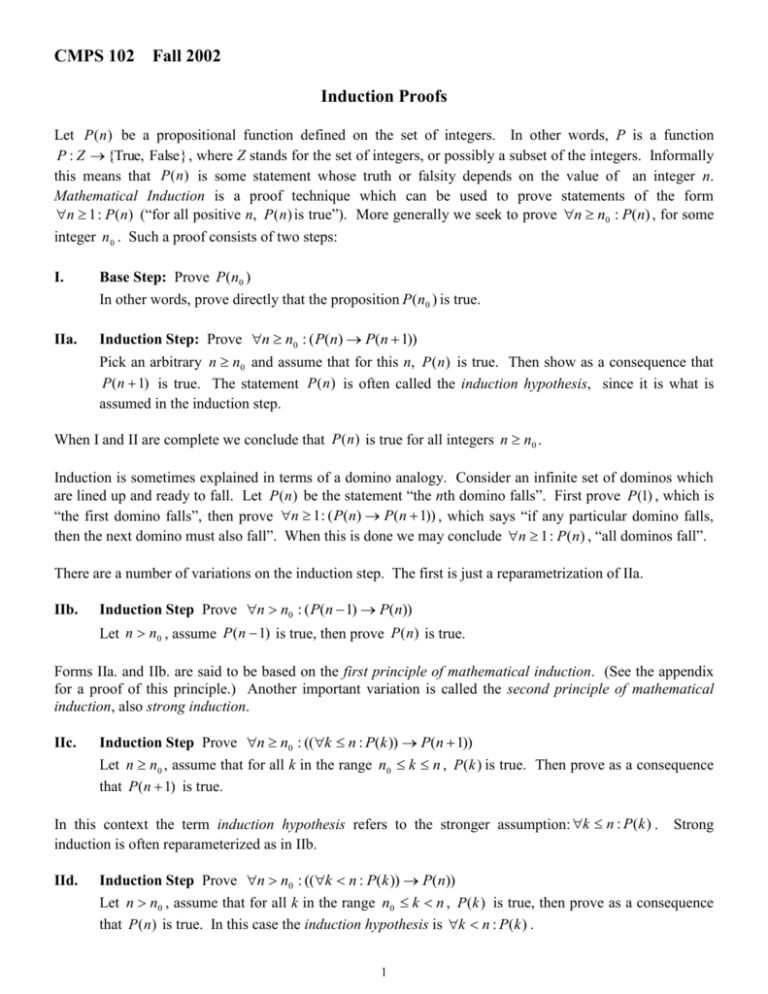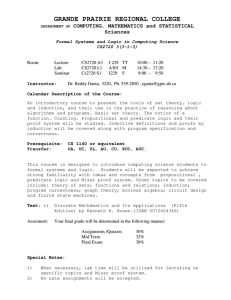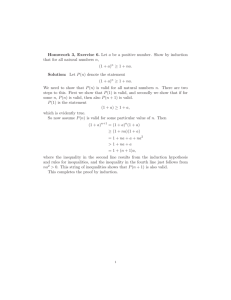Induction Proofs
advertisement

CMPS 102 Fall 2002
Induction Proofs
Let P (n ) be a propositional function defined on the set of integers. In other words, P is a function
P : Z {True, False} , where Z stands for the set of integers, or possibly a subset of the integers. Informally
this means that P (n ) is some statement whose truth or falsity depends on the value of an integer n.
Mathematical Induction is a proof technique which can be used to prove statements of the form
n 1 : P (n) (“for all positive n, P (n ) is true”). More generally we seek to prove n n0 : P(n) , for some
integer n 0 . Such a proof consists of two steps:
I.
Base Step: Prove P(n0 )
In other words, prove directly that the proposition P(n0 ) is true.
IIa.
Induction Step: Prove n n0 : ( P(n) P(n 1))
Pick an arbitrary n n0 and assume that for this n, P (n ) is true. Then show as a consequence that
P (n 1) is true. The statement P (n ) is often called the induction hypothesis, since it is what is
assumed in the induction step.
When I and II are complete we conclude that P (n ) is true for all integers n n0 .
Induction is sometimes explained in terms of a domino analogy. Consider an infinite set of dominos which
are lined up and ready to fall. Let P (n ) be the statement “the nth domino falls”. First prove P (1) , which is
“the first domino falls”, then prove n 1: ( P(n) P(n 1)) , which says “if any particular domino falls,
then the next domino must also fall”. When this is done we may conclude n 1 : P (n) , “all dominos fall”.
There are a number of variations on the induction step. The first is just a reparametrization of IIa.
IIb.
Induction Step Prove n n0 : ( P(n 1) P(n))
Let n n0 , assume P ( n 1) is true, then prove P (n ) is true.
Forms IIa. and IIb. are said to be based on the first principle of mathematical induction. (See the appendix
for a proof of this principle.) Another important variation is called the second principle of mathematical
induction, also strong induction.
IIc.
Induction Step Prove n n0 : ((k n : P(k )) P(n 1))
Let n n0 , assume that for all k in the range n0 k n , P (k ) is true. Then prove as a consequence
that P (n 1) is true.
In this context the term induction hypothesis refers to the stronger assumption: k n : P(k ) .
induction is often reparameterized as in IIb.
IId.
Strong
Induction Step Prove n n0 : ((k n : P(k )) P(n))
Let n n0 , assume that for all k in the range n0 k n , P (k ) is true, then prove as a consequence
that P (n ) is true. In this case the induction hypothesis is k n : P(k ) .
1
Variations IIa and IIb are sometimes called weak induction to contrast with strong induction IIc and IId.
Example 1
Prove that for all n 1:
n
i2
i 1
n(n 1)( 2n 1)
6
Proof:
Let P (n ) be the boxed equation above. We begin the induction at n0 1 .
I.
Base step
1
Clearly
i
2
1
i 1
IIa.
1 (1 1) (2 1 1)
, showing that P (1) is true.
6
Induction Step
Let n 1 and assume P (n ) is true. That is, for this particular value of n, the boxed equation holds.
Then
n 1
i2
i 1
n
i 2 (n 1) 2
i 1
n(n 1)( 2n 1)
(n 1) 2
6
n(n 1)( 2n 1) 6(n 1) 2
6
(n 1) (n 1) 1 2(n 1) 1
6
showing that P (n 1) is true.
(by the induction hypothesis)
(by some algebra)
It follows from the principle of mathematical induction that P (n ) is true for all n 1.
///
One should always state explicitly what is being assumed in the induction step (i.e. what is the induction
hypothesis) One should also make note of the point in the proof at which the induction hypothesis is used.
Example 2
Let x R and x 1 . Show that for all n 0 :
n
i 1
xi
x n1 1
x 1
Proof:
Again let P (n ) be the boxed equation. We begin the induction at n0 0 .
I.
Base step
0
i 0
xi x0 1
x 1
, showing that P (1) is true.
x 1
2
IIb.
Induction Step
Let n 0 and assume that P ( n 1) is true, i.e. assume for this particular n that:
n 1
xi
i 0
xn 1
.
x 1
Then
n
xi
i 0
n 1
xi xn
i 0
xn 1
xn
x 1
x n 1 1
,
x 1
(by induction hypothesis)
showing that P (n ) is true.
Steps I and II prove that P (n ) holds for all n 0 .
///
Often the propositional function P (n ) is not a formula, but some assertion concerning other types of
mathematical structures. Recall that a graph G is a collection of vertices and edges where each edge joins
two (not necessarily distinct) vertices. Two vertices which are joined by an edge are called adjacent. A path
in G consists of a sequence of vertices where each pair of consecutive vertices are adjacent. G is called
connected if every pair of vertices are joined by some path in G. A cycle in G is a closed path, i.e. a path in
which the initial and terminal vertices are identical. G is called acyclic if it contains no cycles. A graph T is
called a tree if it is both connected and acyclic. The following example uses strong induction on the number
of vertices in a graph.
Example 3
Let n 1 and suppose T be a tree on n vertices. Prove that T necessarily has n 1 edges.
Proof:
Let P (n ) be the statement: if T is a tree on n vertices, then T contains n 1 edges.
We begin at n 1.
I.
Base step
If T has just one vertex then, being acyclic, it can have no edges, hence P (1) holds.
IId.
Induction Step (Strong Induction)
Let n 1 and assume that for all k in the range 1 k n , P (k ) is true. That is, for any such k, all
trees on k vertices contain k 1 edges. Now let T be a tree on n vertices. Pick any edge e in T and
remove it. The removal of e splits T into two subtrees, each having fewer than n vertices. Say the
two subtrees have n1 and n2 vertices respectively. Then by our inductive hypothesis the two
subtrees have n1 1 and n2 1 edges respectively. Now replacing the edge e we see that T contains a
total of
(n1 1) (n2 1) 1 n1 n2 1 n 1
edges. (Observe that no vertices were removed so that n1 n2 n .)
///
The result now follows for all trees by induction.
3
There are many other variations on the induction technique. Occasionally we must use double induction,
which involves a modification of both the base and induction steps.
I.
Base Step: Prove P(n0 ) and P(n0 1) .
II.
Induction Step: Prove n (n0 2) : ( P(n 2) P(n 1) P(n)) .
When this is accomplished we may conclude n n0 : P(n) . In terms of our domino analogy we prove that:
(I) the first two dominos fall, and (II) if any two consecutive dominos fall, then the very next domino falls.
From this we deduce that all dominos fall.
The Fibonacci numbers Fn are defined by the recurrence
if n 0
if n 1
if n 2
0
Fn 1
F F
n2
n 1
i.e. each term is the sum of the previous two. Using this recurrence, the first few terms of the sequence are
readily computed as F0 0, F1 1, F2 1, F3 2, F4 3 ,… etc.
Example 4
Prove that for all n 0 ,
Fn
where a
1
5
a
n
bn
1 5
1 5
, and b
.
2
2
Proof:
Let P (n ) denote the boxed equation above.
I.
Base
1
Observe that P (0) and P (1) are true since
II.
5
a
0
b 0 0 F0 and
1
5
a
1
b1 1 F1 .
(Double) Induction
Let n 2 and assume that both P ( n 2) and P ( n 1) are true, i.e. we assume
Fn2
1
5
a
n2
b n2
Thus
Fn Fn 1 Fn 2
1
a
and
n2
Fn 1
1
5
a
n 1
b n 1 .
(a 1) b n2 (b 1) ,
5
One checks that a and b are roots of the quadratic equation: x 2 x 1 0 . Therefore a 2 a 1, and
b 2 b 1 , hence
4
Fn
1
5
a
n2
1
a 2 b n2 b 2
5
a
n
bn ,
showing that P (n ) is true.
Together steps (I) and (II) imply that Fn
1
5
a
n
b n for all n 0 .
///
Often the proposition to be proved is an inequality, as in the next example.
Example 5
Define T (n ) for n Z by the recurrence
0
if n 1
T ( n)
T n / 2 1 if n 2
Prove that for all n 5
T (n) 2 lg( n)
(showing that T (n) O(lg n) .)
Proof:
Let P (n ) be the boxed inequality above.
I.
Base
One checks that T (5) 3 2 lg( 5) , using the recurrence and the fact that 8 25 , so P (5) holds.
IId.
(Strong) Induction
Let n 5 and assume for all k in the range 5 k n that P (k ) is true, i.e. T (k ) 2 lg( k ) . In
particular T n / 2 2 lg n / 2 for k n / 2 . One shows easily that lg x (1 / 2) lg( x) for all
x 1 /( 2 1) . Since n 5 2 /( 2 1) we have n / 2 1 /( 2 1) , hence
T n / 2 2(1 / 2) lg n / 2
Now by the definition of T (n ) :
T (n) T n / 2 1
2(1/ 2) lg n / 2 1
2 lg( n) ,
(by the above inequality)
showing that P (n ) is true.
Therefore T (n) 2 lg( n) for all n 5 as claimed.
///
5
Induction Fallacies
The next few examples illustrate some pitfalls in constructing induction proofs. The result in Example A
below was proved correctly in Example 3. We give an invalid proof of the same fact which illustrates an
argument some authors have called the “induction trap”.
Example A
Show that for all n 1, if T is a tree on n vertices then T has n 1 edges.
Proof: (Invalid)
Base: If n 1 then T has no edges, being acyclic.
Induction: Let n 1 and let T be a tree on n vertices. Assume that T has n 1 edges. Add a new vertex
and join it to T with a new edge. The resulting graph has n 1 vertices and n edges (and is clearly a tree
since connectedness is maintained and no cycles were created.)
By the principle of mathematical induction, all trees on n vertices have n 1 edges.
Let us first observe that this argument does not follow the induction paradigm. In this example P (n ) is of
the form A(n) B(n) where A(n ) is the statement “T is a tree on n vertices”, and B (n ) is “T has n 1
edges”. The induction step should therefore be to prove, for all n 1, P(n) P(n 1) . That is:
( A(n) B(n)) ( A(n 1) B(n 1)) .
To prove this we should assume A(n) B(n) , then assume A(n 1) , then show as a consequence that
B (n 1) is true. In other words we should:
Assume all trees on n vertices have n 1 edges
Assume T has n 1 vertices
Show as a consequence that T has n edges
The above argument did not follow this format however. Instead the arguer does the following.
Assume T has n vertices
Assume T has n 1 edges
Construct a new tree from T having n 1 vertices and n edges
Therefore the above argument was not a proof by induction. Some students would nevertheless hold that the
above argument is still valid, even though it is not a true induction proof. The next example shows
convincingly that it cannot be valid. First we introduce a few more definitions related to graphs. A graph G
is called simple if it contains no loops (edges whose end vertices are identical) and no multiple edges (pairs
of edges with the same end vertices).
Example B:
For all n 1, if G is a simple graph on n vertices, then G has n 1 edges.
We notice right away that the above statement is false since the graph below provides an elementary counterexample. But consider the following “proof” in light of Example A.
6
Proof: (Invalid)
Base: If n 1 then G has no edges, being simple.
Induction: Let n 1 and let G be a simple graph on n vertices. Assume that G has n 1 edges. Add a new
vertex and join it to G with a new edge. The resulting graph has n 1 vertices and n edges (and is clearly
simple since no loops or multiple edges were created.)
By the principle of mathematical induction, all simple graphs on n vertices have n 1 edges.
Observe that Example B follows the format of Example A word for word. Thus if A is valid, so must B be
valid. But the assertion “proved” in B is false! Therefore B cannot be a valid argument, and so neither is A.
Another fallacy comes about by not proving the induction step for all n n0 .
Example C:
Prove that all horses are of the same color.
Proof: (Invalid)
We prove that for all n 1:
if S is a set of n horses, then all horses in S have the same color.
The result follows on letting S be the set of all horses. Let P (n ) be the boxed statement, and proceed by
induction on n.
Base: Let n 1. Obviously if S is a set consisting of just one horse, then all horses in S must have the same
color. Thus P (1) is true.
Induction: Let n 1 and assume that in any set of n horses, all horses are of the same color. Let S be a set
of n 1 horses, say S h1 , h2 , h3 ,, hn1 . Then the sets
S {h2 , h3 ,, hn1} S {h1}
and
S {h1 , h3 ,, hn1} S {h2 }
each contain exactly n horses, and so by the induction hypothesis all horses in S are of one color, and
likewise for S . Observe that h3 S S and that h3 can have only one color. Therefore the color of the
horses in S is identical to that of the horses in S . (Note n 1 n 2 n 1 3 , so there is in fact a
third horse, and he can have only one color.) Since S S S it follows that all horses in S are of the same
color. Therefore P(n) P(n 1) for all n 1.
The result now follows by induction.
Obviously the proposition being proved is false, so there is something wrong with the proof, but what? The
base step is certainly correct, and the induction step, as stated, is also correct. The problem is that the
induction step was not quantified properly. We should have proved n 1 : P(n) P(n 1) Instead we
proved (correctly) that n 1 : P(n) P(n 1) . Indeed it is true that P(2) P(3) for instance, but we
never proved (and it is false that) P(1) P(2) .
7
In terms of the domino analogy, it is as if the first domino falls; and if any domino indexed 2 or above were
to fall, then the next domino would fall; but the first domino is not sufficient to topple the second domino,
and hence no domino other than the first actually falls.
Appendix: Proof of the first principle of mathematical induction.
We prove for any propositional function P (n ) defined on the positive integers Z , that
P(1) n 1 : P(n 1) P(n) n 1 : P(n)
is a tautology. The proof is based on the well ordering property of the positive integers:
Any non-empty set of positive integers contains a least element.
Proof:
Assume that the statements P (1) and n 1 : P(n 1) P(n) are true. Let S {n Z : P(n) is false } . It
will be sufficient to show that S . Assume, to get a contradiction, that S . Then S contains a least
element by the well ordering property. Let m denote this smallest element in S. Since P (1) is true, 1 S
and so m 1. Therefore m 1 1 , and since m is the smallest element in S, m 1 S , hence P ( m 1) is
true. But this implies that P (m ) is true by setting n m in the statement n 1 : P(n 1) P(n) . Thus
m S , contradicting the very definition of m as the smallest element in S. This contradiction shows that our
assumption must be false, and therefore S as required.
///
8








